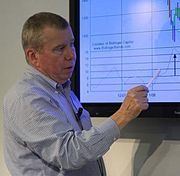Nationality American Name John Bollinger | Role Author Education School of Visual Arts | |
 | ||
Occupation Non-fiction writer, Financial Analyst Notable awards 2005 Market Technicians Association Annual Award for Outstanding Contribution to the Field of Technical Analysis, 1995 Technical Securities Analysts of San Francisco Lifetime Award for Outstanding Achievement in Technical Analysis. Bollinger has been the driving force in establishing technical analysis as an important and respected discipline in equity and futures analysis. 2015 International Federation of Technical Analysts, IFTA Lifetime Achievement Award. Recognition for a lifetime of contribution, hard work, and total dedication adding significance to the field of technical analysis. Books Bollinger on Bollinger bands Similar People Alexander Elder, Linda Bradford Raschke, Thomas DeMark | ||
Using bollinger bands to find winning trades john bollinger
John A. Bollinger (born May 27, 1950) is an American author, financial analyst, contributor to the field of technical analysis and the developer of Bollinger Bands. His book Bollinger on Bollinger Bands, John Bollinger, McGraw Hill, 2002, ISBN 978-0-07-137368-5, has been translated into eleven languages. He has published The ’’Capital Growth Letter’’ which provides technical analysis of the financial markets since 1987.
Contents
- Using bollinger bands to find winning trades john bollinger
- John bollinger webinar on bollinger bands and japanese candlesticks
- Bollinger Bands
- Rational Analysis
- Computerized Technical Analysis
- Professional Life
- Board Memberships
- Member of
- Articles and Books by John Bollinger
- Articles about John Bollinger and his work
- References

John bollinger webinar on bollinger bands and japanese candlesticks
Bollinger Bands

Bollinger Bands are intervals drawn on a price chart that define high and low on a relative basis. Bollinger started developing Bollinger Bands in the early 1980s. They are an adaptation of Keltner Bands and similar to Donchian channels. He was trading options at the time and much of his analytics involved volatility. At the time fixed width trading bands were in use. Mr. Bollinger's contribution was to use volatility standard deviation to make trading bands adaptive.
When they were introduced to the public on Financial News Network they didn't have a name. His interviewer pointed to the chart and said "What are those?" and Bollinger said "Let's call them Bollinger Bands." That was how they got their name.
Rational Analysis

“John Bollinger, CFA, has always concentrated on the overlap between technical and fundamental analysis, rather than focus on the differences. To bridge the gap between fundamental and technical analysis, Bollinger advocates an approach he calls ‘Rational Analysis’”. Bollinger first coined the term “Rational Analysis” in the late 1980s. He then defined it as the “juncture of the overlap between technical and fundamental analysis” and created a visual representation.

At the 2004 AIMR Conference, in his presentation titled Combining Technical and Fundamental Analysis, he took his concept one step further. Because the financial analysis community sub-categorizes itself in ever finer specialty groups, his updated definition of Rational Analysis was stated as “the union of the sets of technical, fundamental, quantitative and behavioral analysis”.
The analogy Bollinger uses for Rational Analysis is having multiple tool kits each with different tools. To get the job done the rational approach is to take the tool that does the job best, regardless of which tool kit it comes from. The same is true for financial analysis. Depending on the analytical scenario, sometimes technical analysis tools provide the best insights. Sometimes fundamental analysis, behavioral analysis or quantitative analysis; and most often a combination of all four is the most rigorous and productive.
Computerized Technical Analysis
After purchasing his first microcomputer in 1977, Bollinger became involved in the seminal stages of computer driven technical analysis. Computer technology allowed Bollinger to develop Group Power, an industry group ranking system that shows developing trends in industry groups and sectors. Over the years the service evolved, the underlying structure becoming a proprietary equal-weighted industry group structure and delivery via the Internet allowed ever more complex analytics.
In 1996 Bollinger recognized the potential of the Internet for financial analysis and began the programming for www.equitytrader.com. The service utilized a 52 rule fuzzy logic model to provide analytics of the US equities market and was one of earliest charting and technical analysis websites.
Professional Life
After becoming an independent trader in 1980 he joined the Financial News Network where he was the Chief Market Analyst for seven years, 1984–1990, a role in which he had primary responsibility for the technical analysis content presented on air. After FNN was purchased by NBC Bollinger helped with the transition to CNBC and continued to provide commentary on CNBC on a regular basis. He founded his own firm, Bollinger Capital Management, an investment management and research firm. Bollinger is both a CFA Chartered Financial Analyst and CMT Chartered Market Technician and was the first financial analyst to earn both designations. Bollinger is the recipient of the Technical Securities Analysts Association of San Francisco Lifetime Award for Outstanding Achievement in Technical Analysis and the 2005 Market Technicians Association Annual Award for Outstanding Contribution to the Field of Technical Analysis. He is also the founding president of Market Analysts of Southern California. Bollinger is the president and founder of Bollinger Capital Management, an investment management company that provides technically driven money management services and develops proprietary research for institutions and individuals.
Board Memberships
Bollinger served on the board of the Market Technicians Association (MTA) for ten years (1988-1997), on the board of International Federation of Technical Analysts (IFTA) for five years (1998-2003) and on the board of the Market Technicians Association Education Foundation (MTAEF) from 2008 though 2012.
Member of
CFA Institute [1]
CFA Society Los Angeles [2]
Technical Securities Analysts Association [3]
Market Technicians Association [4]
Articles and Books by John Bollinger
Bollinger, John (2001). Bollinger on Bollinger Bands. McGraw Hill. ISBN 0-07-137368-3.
Les bandes de Bollinger, John Bollinger. Valor Editions. ISBN 2-909356-34-5
MetaStock Monitor, March 2009, Bollinger Band Basics
SFO Magazine, February 2003, Bollinger Bands and Volume Oscillator Pair Up For Range Trading Stock Strategy
Active Trader, March 2002, Volume Indicators Revisited
Technical Analysis of Stocks & Commodities, February 1992, Using Bollinger Bands
Technical Analysis of Stocks & Commodities, March 1993, Put Volume Indicators
Articles about John Bollinger and his work
Los Angeles Times, December 7, 2008, John Bollinger: Stock Scholar, Walter Hamilton
CFA Magazine, November 2005, John Bollinger Profile, Nancy Opiela
SFO Magazine, February 2003, Bollinger Bands and Volume Oscillator Pair Up For Range Trading Stock Strategy, John Bollinger
Active Trader, February 2001, John Bollinger: Focus on the Markets, Interview with John Bollinger
Active Trader, April 2003, Relatively Speaking, Interview with John Bollinger
The Technical Analyst, January 2009, Techniques for Recognizing Market Bottoms
SFO Magazine, August 2008, Tips from the Pros, Matt Blackman
Technical Analysis of Stocks & Commodities, Interview: John Bollinger of Bollinger Bands Fame, by Jayanthi Gopalakrishnan
